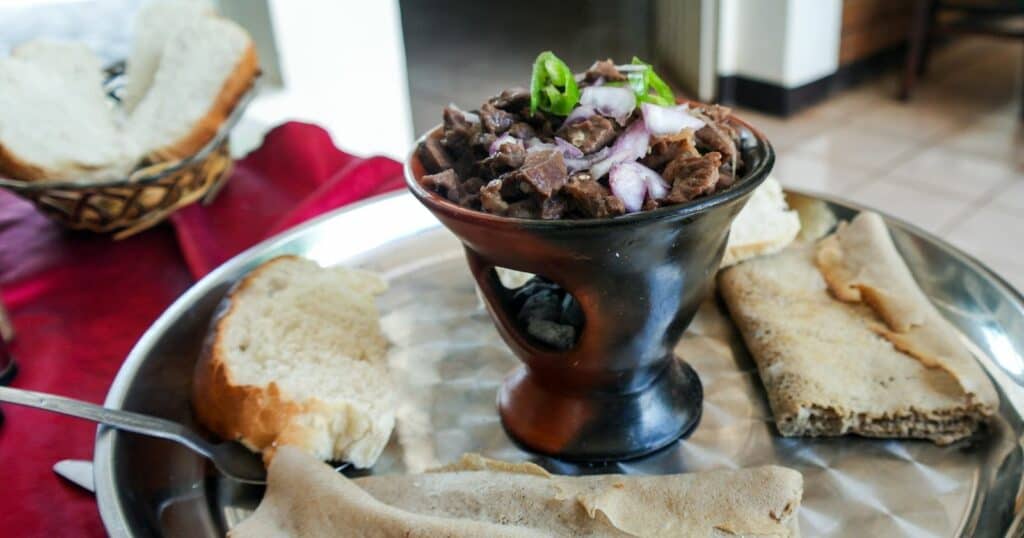Ethiopian food is one of the most exciting cuisines in the world. It’s filled with spices and flavors that will leave your mouth watering as you try to eat more of it!
Ethiopian food is spicy, but not as spicy as Indian, Mexican, or Thai Food. Ethiopian food has a lot of spices; Berbere is a crucial ingredient in many Ethiopian dishes. Berbere is a
This article will cover some of the most popular spicy Ethiopian dishes and explain why they’re so delicious.
7 Spiciest food in Ethiopia
Sik Sik Wat

Sik Sik Wat is a popular spicy Ethiopian dish made with beef or lamb. The meat is cooked in a stew with berbere, a
Misir Wat

If you’re looking for an incredibly flavorful and hearty vegetarian dish, look no further than Misir Wat. This Ethiopian staple is made with red lentils and is absolutely packed with flavor. The onions are slowly caramelized in niter kibbeh, Ethiopia’s delicious spiced clarified butter. Then garlic and tomato paste are added.
And, of course, there’s a generous dose of berbere, Ethiopia’s famous chili seasoning blend. It’s usually quite fiery, so be prepared for some severe heat! But trust me, it’s worth it.
Doro Wat

Doro Wat is another Ethiopian classic and one of the spiciest dishes you’ll find. It’s made with chicken (traditionally), but you can also find it made with lamb or beef. The meat is cooked in a stew with berbere, onions, garlic, ginger, and other spices.
Derek Tibs

Derek Tibs is my favorite way to eat steak. It’s simple but oh so delicious. The key is to get a good sear on the meat and to use butter instead of oil. This gives the Derek Tibs a rich flavor that you can’t get with other methods of cooking steak.
The key is to serve it in a flaming hot earthenware dish with hot coals on the bottom. This keeps the Derek Tibs sizzling hot, and you get some meat crispies at the bottom. Yum! Derek Tibs is the way to go if you’re looking for a new way to enjoy steak.
Shiro Wat

Shiro Wat is a thick chickpea stew simmered and served over their traditional sour flatbread, injera, with other vegetarian dishes. It’s a staple in any Ethiopian vegetarian platter, and it’s damn good.
The key to a good Shiro Wat is in the slow cooking process, which allows the flavors to meld together, creating a rich, flavorful stew. Serve it with a dollop of yogurt on top, and you’ve got a dish that will satisfy any appetite.
Beyaynetu

A Beyaynetu is an Ethiopian vegetarian platter that typically features a variety of dishes, including Shiro wat (a chickpea stew), Misir wat (a lentil stew), and Kik Alicha (a yellow split pea stew), Atkilt wot (cabbage and carrot stew), and more. It’s a great way to sample a variety of Ethiopian dishes, and it’s perfect for vegetarians or those looking for a hearty but meat-free meal.
Azifa

Azifa is a cold lentil dish that’s perfect for a hot day. The lentils are cooked with onions, garlic, ginger, and spices, then chilled and served with a lemon vinaigrette. It’s a refreshing and flavorful dish perfect as a side or as a main course.
Spices used in Ethiopia Cuisine
The spices used in Ethiopian cuisine are unique. The country is landlocked in the Horn of Africa, meaning it has no access to any ocean or sea. This makes its spices more potent than those from other countries because they have to use them in their dishes to compensate for this lack of freshness.
Berbere
Berbere is one of these spices found in most Ethiopian restaurants worldwide. It’s made using chili peppers, garlic and ginger roots, and other ingredients like onions and tomatoes, which give it an earthy taste while adding more flavor depth when combined with other ingredients such as chicken or beef.
Turmeric
Turmeric is another popular
Koreima
Koreima is a lesser-known
Niter Kibbeh
Niter kibbeh is clarified butter that’s used extensively in Ethiopian cooking. It’s made by simmering butter with onions, garlic, and other spices, then strained to remove any solids. Niter kibbeh adds a rich flavor to dishes, and it’s what makes Ethiopian food so unique.
Things you should know about Ethiopian food.
What does Wat mean?
Wat is a type of stew that’s popular in Ethiopia. It’s typically made with chicken, beef, or lamb and simmered with spices until it’s nice and thick.
What foods is Ethiopia known for?
Ethiopia is known for its coffee, some of the best in the world. The country is also known for its stews, or wat, and its flatbread, injera.
Is Ethiopian food the spiciest in Africa?
No, Ethiopian food is not the spiciest in Africa. It’s relatively mild compared to other African cuisines. However, that doesn’t mean it’s not flavorful. The spices used in Ethiopian dishes are unique and create a flavor profile, unlike any other cuisine.
Final Thought
Ethiopian food is the cuisine for you if you’re looking for a flavor adventure. With its unique





